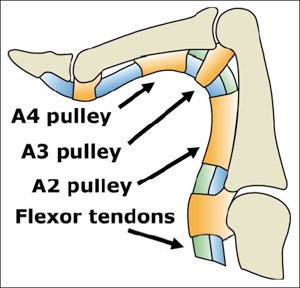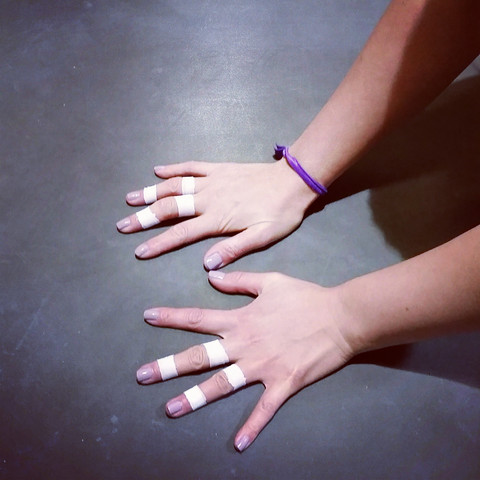Taping fingers for rock climbing provides support and helps prevent injuries, enhancing grip strength and stability on the wall. At rockscapes.net, we understand the importance of finger care and proper taping techniques for climbers of all levels, helping you maintain peak performance and minimize the risk of strains or tears. Explore effective methods and tips to keep your fingers protected and ready for your next climb, maximizing your time enjoying beautiful rock formations and landscapes.
1. What Is Finger Taping For Rock Climbing And Why Is It Important?
Finger taping for rock climbing is a technique used to provide support, stability, and protection to the fingers, reducing the risk of injury and enhancing performance. It’s important because climbing places significant stress on the fingers, making them susceptible to sprains, strains, and pulley injuries.
1.1 The Stresses on Climber’s Fingers
Rock climbing involves a variety of grips and movements that place tremendous stress on the fingers. According to a study by the Journal of Hand Surgery, climbers’ fingers endure forces several times their body weight, increasing the risk of injuries to tendons, ligaments, and pulleys.
1.2 Benefits Of Finger Taping
Taping offers several key benefits:
- Support: Provides extra support to joints and ligaments.
- Stability: Enhances stability, reducing the risk of dislocations and hyperextension.
- Protection: Protects the skin from abrasions and blisters.
- Injury Prevention: Minimizes the risk of common climbing injuries like pulley tears.
1.3 Common Injuries In Rock Climbing
Common finger injuries in rock climbing include:
- Pulley Tears: Tears in the annular pulleys that hold tendons close to the bones.
- Tendonitis: Inflammation of the tendons.
- Joint Sprains: Ligament damage in the finger joints.
- Skin Abrasions: Cuts and blisters on the fingertips.
2. Understanding Finger Anatomy: Essential For Effective Taping
A basic understanding of finger anatomy is crucial for effective taping, ensuring support where it’s needed most and avoiding restriction of movement.
2.1 Basic Finger Anatomy
Fingers consist of bones (phalanges), joints, ligaments, tendons, and pulleys, all working in harmony.
- Phalanges: The bones that make up the finger.
- Joints: Allow for movement and flexibility.
- Ligaments: Connect bones to each other, providing stability.
- Tendons: Connect muscles to bones, enabling movement.
- Pulleys: Fibrous sheaths that hold tendons close to the bones, essential for efficient finger flexion.
 Finger anatomy
Finger anatomy
2.2 Role Of Pulleys
Pulleys are critical in finger function. They keep the flexor tendons close to the bones, allowing climbers to maintain a strong grip.
2.3 Common Pulley Injuries
Pulley injuries, particularly A2 and A4 pulley tears, are common in rock climbing. According to research from the American Journal of Sports Medicine, these injuries often occur due to overuse or sudden, forceful crimping.
3. Types Of Climbing Tape: Choosing The Right One
Selecting the right type of climbing tape is essential for comfort, support, and durability. Different tapes offer varying levels of adhesion, elasticity, and breathability.
3.1 Different Types Of Climbing Tape
- Athletic Tape (Rigid Tape): Offers strong support and is ideal for immobilizing joints.
- Elastic Adhesive Bandage (EAB): Provides flexibility and compression, suitable for active support.
- Cloth Tape: A versatile option with good adhesion and moderate support.
3.2 Pros And Cons Of Each Type
| Type | Pros | Cons |
|---|---|---|
| Athletic Tape | Strong support, immobilizes joints, durable | Limited flexibility, can restrict movement |
| Elastic Adhesive | Flexible, provides compression, comfortable | Less support than athletic tape, may lose adhesion when wet |
| Cloth Tape | Good adhesion, versatile, breathable | Moderate support, may not be as durable as athletic tape |
3.3 Factors To Consider When Choosing Tape
- Adhesion: How well the tape sticks to the skin.
- Elasticity: The degree of stretch and flexibility.
- Breathability: How well the tape allows air to circulate, reducing moisture buildup.
- Durability: The tape’s resistance to wear and tear.
4. Essential Supplies For Finger Taping
Having the right supplies on hand makes the taping process more efficient and effective.
4.1 List Of Necessary Items
- Climbing Tape: Choose the appropriate type for your needs.
- Scissors or Tape Cutter: For precise cutting.
- Skin Cleanser: To clean and prepare the skin.
- Pre-Wrap (Optional): To protect sensitive skin and reduce irritation.
- Antiseptic Wipes: For cleaning minor cuts or abrasions.
4.2 Preparing Your Fingers For Taping
- Clean Your Hands: Wash thoroughly with soap and water.
- Clean the Skin: Use a skin cleanser or alcohol wipe to remove oils and dirt from the fingers.
- Dry Your Fingers: Ensure your fingers are completely dry before applying tape.
- Apply Pre-Wrap (Optional): If you have sensitive skin, apply a layer of pre-wrap to protect it from direct contact with the tape.
4.3 How To Cut Tape Properly
- Use Sharp Scissors: Ensure your scissors are sharp for clean cuts.
- Cut to Size: Pre-cut tape strips to the desired length for each taping technique.
- Avoid Jagged Edges: Smooth edges prevent the tape from peeling off easily.
5. Basic Finger Taping Techniques For Rock Climbing
Mastering basic taping techniques is essential for providing effective support and protection to your fingers.
5.1 The Buddy Taping Method
Buddy taping involves taping an injured finger to an adjacent, uninjured finger for support.
- Preparation: Clean and dry both fingers.
- Alignment: Align the injured finger with the healthy finger.
- Padding: Place a small piece of padding (e.g., cotton or foam) between the fingers to prevent skin irritation.
- Taping: Wrap tape around both fingers, starting just below the joint and moving upward.
- Secure: Ensure the tape is snug but not too tight, allowing for circulation.
5.2 The A-Frame Technique
The A-frame technique provides targeted support to a specific joint, preventing hyperextension.
- Preparation: Clean and dry the finger.
- Anchor Strip: Apply a strip of tape around the finger just below the joint.
- A-Frame Strips: Create two strips of tape that start on either side of the anchor strip, crossing over the joint in an “A” shape.
- Secure: Apply another anchor strip above the joint to secure the A-frame.
5.3 The Spiral Wrap Method
The spiral wrap method provides overall support and compression to the entire finger.
- Preparation: Clean and dry the finger.
- Anchor Strip: Apply a strip of tape at the base of the finger.
- Spiral Wrap: Wrap the tape around the finger in a spiral pattern, overlapping each layer slightly.
- Secure: Finish with a final strip of tape at the tip of the finger.
6. Advanced Taping Techniques For Specific Injuries
For more specific injuries like pulley tears, advanced taping techniques can provide additional support and protection.
6.1 Taping For Pulley Injuries (H-Method)
The H-method is designed to support the annular pulleys and prevent further injury. Despite research suggesting its limited effectiveness, many climbers find it beneficial.
- Preparation: Clean and dry the finger.
- Vertical Strips: Apply two vertical strips of tape on either side of the injured pulley.
- Horizontal Strips: Apply two horizontal strips of tape, one above and one below the vertical strips, forming an “H” shape.
- Secure: Wrap additional tape around the entire finger to secure the H-shape.
 Bouldering Babes taped climber hands
Bouldering Babes taped climber hands
6.2 Taping For Joint Instability (X-Method)
The X-method is used to stabilize unstable finger joints.
- Preparation: Clean and dry the finger.
- Anchor Strip: Apply a strip of tape around the finger below the joint.
- X-Strips: Create two strips of tape that cross over the joint in an “X” shape, starting from opposite sides.
- Secure: Apply another anchor strip above the joint to secure the X-strips.
6.3 Taping For Skin Protection
Taping can protect the skin from abrasions and blisters, especially in high-friction areas.
- Preparation: Clean and dry the area.
- Apply Tape: Cover the area with a single layer of tape, ensuring it is smooth and wrinkle-free.
- Secure: Secure the edges to prevent peeling.
7. Dos And Don’ts Of Finger Taping
Following these guidelines ensures you’re taping your fingers effectively and safely.
7.1 Important Considerations
- Do clean and dry your fingers before taping.
- Do use the right type of tape for your needs.
- Do apply tape snugly, but not too tight.
- Do remove tape if you experience numbness or tingling.
- Do seek professional medical advice for serious injuries.
7.2 Common Mistakes To Avoid
- Don’t apply tape too tightly, restricting circulation.
- Don’t reuse tape.
- Don’t ignore pain or discomfort.
- Don’t rely on tape to fix serious injuries.
- Don’t leave tape on for extended periods without breaks.
7.3 When To Seek Professional Help
Seek professional medical advice if you experience:
- Severe pain
- Swelling
- Numbness
- Inability to move the finger
- A popping sensation during an injury
8. Tips For Maintaining Healthy Fingers
Beyond taping, maintaining overall finger health is crucial for long-term climbing success.
8.1 Warm-Up Exercises
Perform warm-up exercises before each climbing session to prepare your fingers for the stresses of climbing.
- Finger Stretches: Gently extend and flex each finger.
- Wrist Rotations: Rotate your wrists in both directions.
- Hand Squeezes: Squeeze a stress ball or hand grip strengthener.
8.2 Strengthening Exercises
Incorporate strengthening exercises into your training routine to build finger strength and endurance.
- Hangboarding: Hang from a hangboard to build finger strength.
- Rice Bucket Exercises: Perform various exercises in a bucket of rice to strengthen hand and forearm muscles.
- Grip Strengtheners: Use grip strengtheners to improve overall grip strength.
8.3 Stretching And Cooling Down
Stretch and cool down after each climbing session to reduce muscle tension and promote recovery.
- Finger Extensions: Gently pull each finger back to stretch the tendons.
- Prayer Stretch: Press your palms together in front of your chest, then lower your hands towards your waist to stretch your wrists and forearms.
8.4 Nutrition And Hydration
Proper nutrition and hydration play a key role in maintaining healthy fingers.
- Stay Hydrated: Drink plenty of water to keep your muscles and tendons hydrated.
- Balanced Diet: Eat a balanced diet rich in protein, vitamins, and minerals to support tissue repair and growth.
- Anti-Inflammatory Foods: Include foods with anti-inflammatory properties, such as fruits, vegetables, and omega-3 fatty acids.
9. Real-World Examples And Case Studies
Examining real-world examples and case studies can provide valuable insights into effective finger taping practices.
9.1 Case Study 1: Pulley Injury Recovery
A climber experienced an A2 pulley tear and used the H-method taping technique in conjunction with rest and rehabilitation exercises. Over several weeks, the climber gradually regained strength and was able to return to climbing without pain.
9.2 Case Study 2: Preventing Skin Abrasions
A climber with sensitive skin consistently experienced abrasions on their fingertips. By using tape to protect the skin during climbs, they were able to prevent further injuries and climb more comfortably.
9.3 Expert Interviews And Testimonials
According to Dr. Emily Carter, a sports medicine physician specializing in climbing injuries, “Proper finger taping can provide valuable support and protection, but it’s essential to use the correct techniques and listen to your body. If you experience persistent pain or discomfort, seek professional medical advice.”
10. Environmental Responsibility And Tape Disposal
Proper disposal of climbing tape is essential for maintaining the cleanliness and sustainability of climbing areas.
10.1 The Impact Of Litter On Climbing Areas
Litter, including discarded climbing tape, can have a significant impact on the environment, detracting from the natural beauty of climbing areas and potentially harming wildlife.
10.2 Best Practices For Tape Disposal
- Pack It In, Pack It Out: Always carry out all tape and trash.
- Use Biodegradable Tape: Consider using biodegradable tape options to reduce environmental impact.
- Dispose Properly: Dispose of used tape in designated trash receptacles.
10.3 Sustainable Alternatives To Traditional Tape
Explore sustainable alternatives to traditional climbing tape, such as:
- Biodegradable Tape: Made from natural, renewable materials.
- Reusable Finger Sleeves: Provide protection and support without the need for disposable tape.
11. FAQs About Finger Taping For Rock Climbing
Here are some frequently asked questions about finger taping for rock climbing.
11.1 Does Taping Actually Prevent Injuries?
Taping can help prevent minor injuries by providing support and protection, but it’s not a foolproof solution and should be combined with proper training and technique.
11.2 How Tight Should The Tape Be?
The tape should be snug but not so tight that it restricts circulation or causes numbness.
11.3 Can I Reuse Climbing Tape?
No, climbing tape should not be reused, as it loses its adhesive properties and can harbor bacteria.
11.4 How Often Should I Replace The Tape?
Replace the tape whenever it becomes loose, dirty, or loses its adhesiveness.
11.5 What If I Develop A Skin Reaction To The Tape?
If you develop a skin reaction, discontinue use and try a different type of tape or use a pre-wrap to protect your skin.
11.6 Can I Climb With Tape On Every Finger?
While you can tape multiple fingers, it’s generally best to only tape the fingers that need support to avoid restricting movement.
11.7 Is Taping A Substitute For Proper Training?
No, taping is not a substitute for proper training, warm-up, and cool-down routines.
11.8 How Long Should I Leave Tape On My Fingers?
Remove the tape as soon as possible after your climbing session to allow your skin to breathe and recover.
11.9 Can I Shower With Tape On?
It’s best to avoid showering with tape on, as moisture can reduce its adhesiveness and irritate the skin.
11.10 Where Can I Buy Climbing Tape?
Climbing tape is available at most climbing gyms, outdoor retailers, and online stores.
12. Maximizing Performance And Safety
Mastering finger taping is just one aspect of maximizing performance and safety in rock climbing.
12.1 Integrating Taping Into Your Climbing Routine
Make finger taping a regular part of your climbing routine to provide consistent support and protection.
12.2 Listening To Your Body
Pay attention to your body and address any pain or discomfort promptly.
12.3 The Importance Of Rest And Recovery
Prioritize rest and recovery to allow your fingers to heal and rebuild.
12.4 Consulting With Experts
Consult with experienced climbers, coaches, or medical professionals for personalized advice and guidance.
13. Rockscapes.Net: Your Partner In Climbing Safety And Success
At rockscapes.net, we are dedicated to providing climbers with the resources and information they need to stay safe and perform their best.
13.1 Explore Our Range Of Articles
Explore our range of articles on climbing techniques, injury prevention, and gear reviews.
13.2 Expert Advice And Tips
Benefit from expert advice and tips from experienced climbers and medical professionals.
13.3 Community Forums
Join our community forums to connect with other climbers, share experiences, and ask questions.
13.4 Stay Updated With The Latest Trends
Stay updated with the latest trends and developments in the world of rock climbing.
Taping your fingers correctly can make a significant difference in your climbing performance and safety, providing the necessary support and protection to prevent injuries. At rockscapes.net, we encourage you to explore our resources and take advantage of our expert advice to enhance your climbing experience.
Ready to take your climbing to the next level? Visit rockscapes.net today for more information on finger care, training tips, and the latest in climbing gear. Don’t let injuries hold you back – discover how our comprehensive resources can help you climb stronger and safer. Explore stunning landscape designs and innovative uses of natural stone to inspire your next adventure, and connect with our experts for personalized advice. Start your journey to climbing excellence with rockscapes.net today.
Address: 1151 S Forest Ave, Tempe, AZ 85281, United States.
Phone: +1 (480) 965-9011.
Website: rockscapes.net.
